This induction is dedicated to the late “Mean” Gene Okerlund, whose hijinks and horniness left and indelible mark on this pay-per-view broadcast.
WCW made a lot of odd choices throughout its existence, not the least of which was tinkering with its annual Starrcade event, the oldest televised supercard in the wrestling world, by devoting the entire 1991 event to Battlebowl.
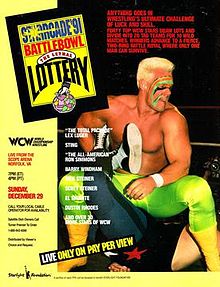
The idea behind Battlebowl was that the card would be nothing but tag team matches between supposedly random teams of individual wrestlers, with the winners of those matches advancing to a battle royal in the finale.
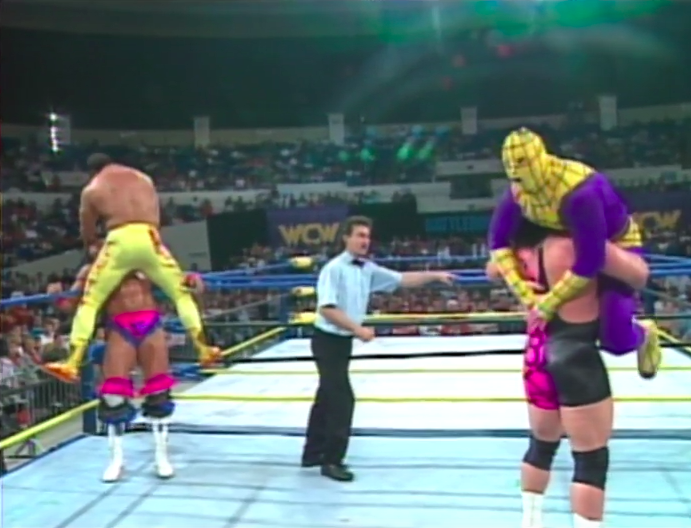
Typically, these matches mixed heels and faces together on the same team, making it difficult for fans to know who to root for.
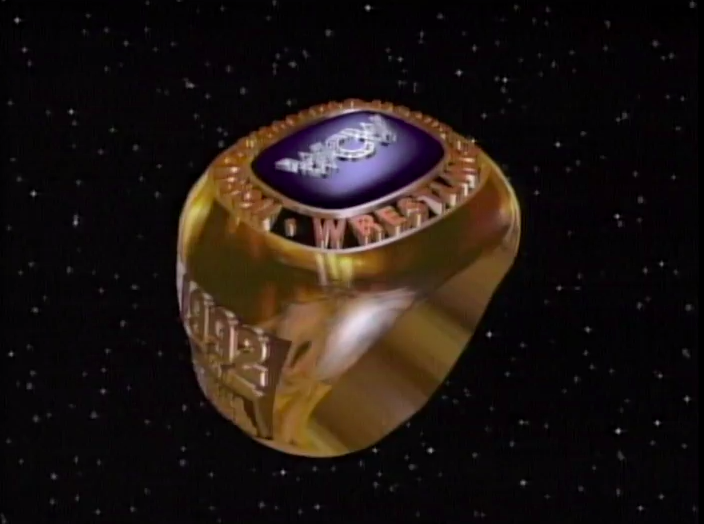
And as if all that weren’t enough to make fans tune out from apathy, the only prize offered to the winner of this cluster was a piece of jewelry.
Not surprisingly, these events were hardly pay-per-view juggernauts. The all-Battlebowl Starrcade ’91 drew only a 1.0 buyrate, down from 1.30 the previous year.
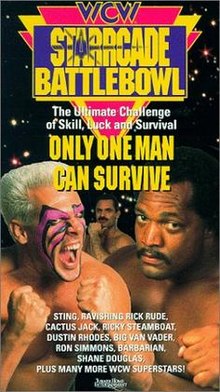
Starrcade ’92, which included a scaled-down version of Battlebowl, drew only a 0.50.
Clearly, WCW thought, the problem was that there wasn’t enough Battlebowl. Thus, in November 1993, Battlebowl got its very first stand-alone pay-per-view.
And, because it drew the very lowest WCW pay-per-view numbers (0.27) until the bottom fell out completely in 2000, this was also Battlebowl’s very last stand-alone pay-per-view.
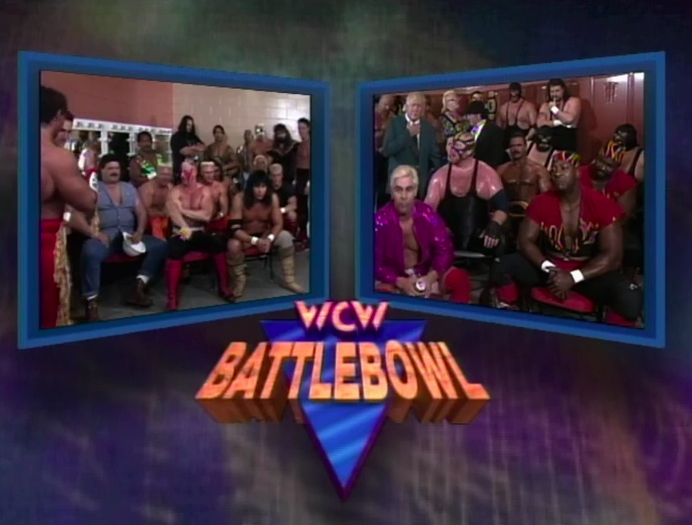
This year, 40 men were entered into the Lethal Lottery for 32 spots in the card’s eight tag team matches. This meant that eight unlucky men would go undrafted, not even getting the opportunity to compete for the coveted Battlebowl championship ring.
In reality, there were only 33 wrestlers on hand, and WCW really had to stretch to get to even that number, putting the likes of Rip Rogers on their pay-per-view card.
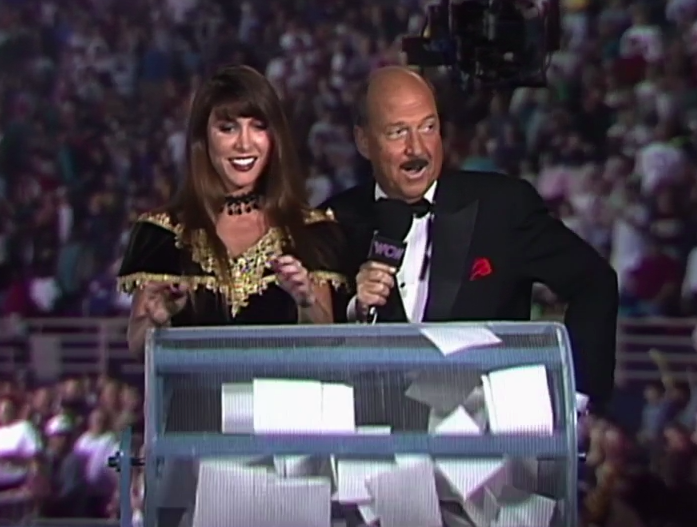
If Sid and Arn Anderson hadn’t tried to kill each other on WCW’s tour of England, I somehow doubt Rip’s name would have been *ahem* randomly selected by Mean Gene Okerlund and Fifi, who handled the tumbler full of envelopes.
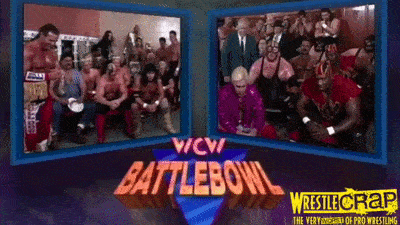
Vader must not have appreciated Rip being in the locker room, either, as he decked the enhancement talent as soon as the World Champion heard his name called as Cactus Jack’s partner.
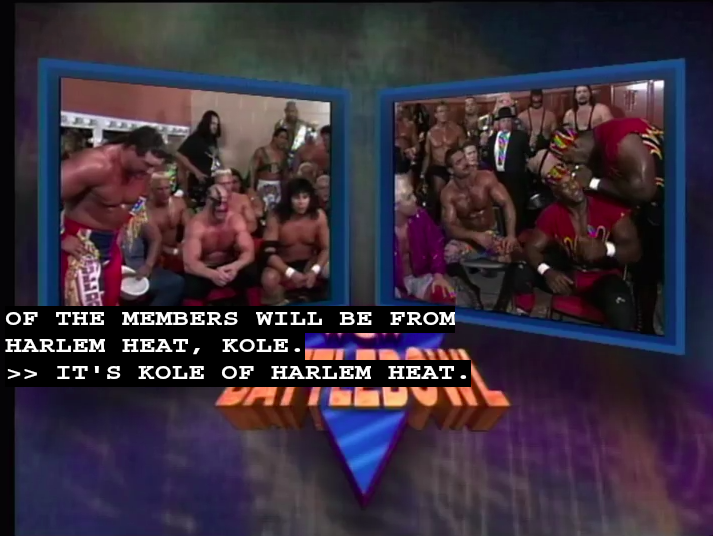
Next, Mean Gene announced that Kole of the Harlem Heat would be wrestling on the opposing team. This was back before they went by Booker T and Stevie Ray; I can’t remember which one was Kole…
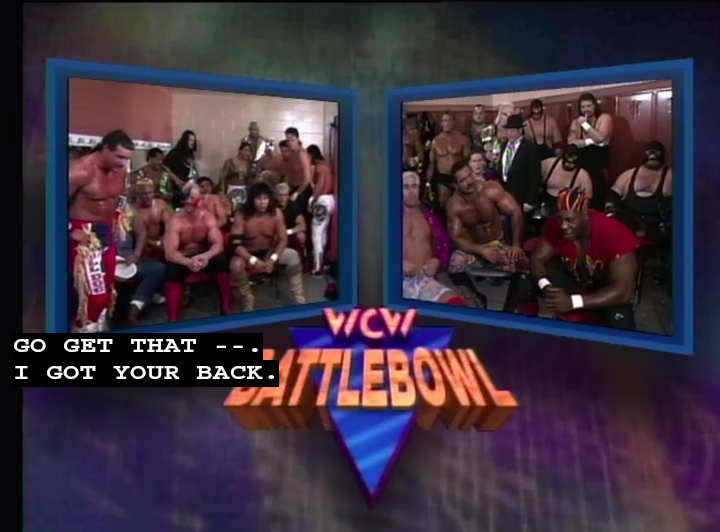
…but apparently, neither could Harlem Heat themselves, as Tony Schiavone was quick to point out that the wrong member (Stevie Ray, AKA “Kane”) came to the ring.
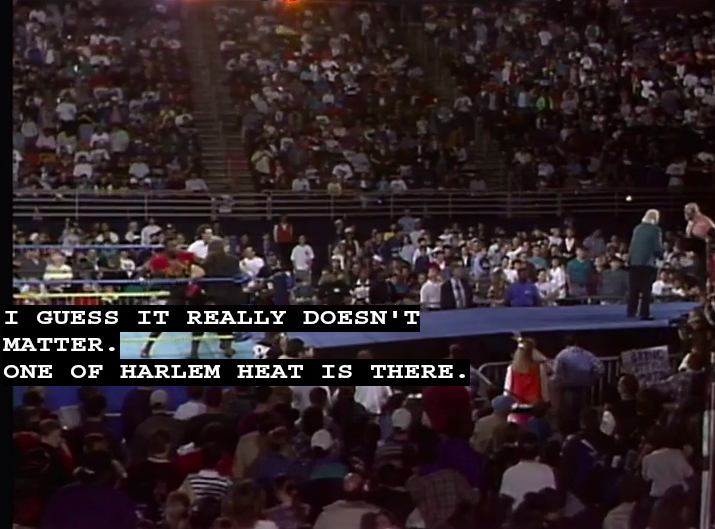
“I guess it really doesn’t matter”, says Schiavone, not exactly putting over the whole Lethal Lottery concept. Mean Gene had clearly forgotten which name to announce and in the process let the the audience know that the cards he was drawing were all blank.
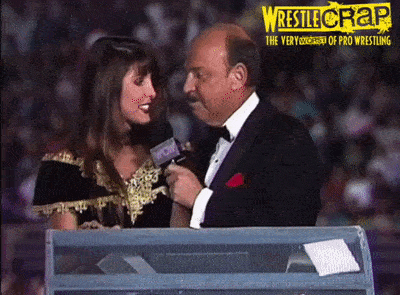
This would be far from Gene’s only boner of the evening, though, as the old horndog would find himself in an awkward spot with Ric Flair’s maid (and future wife) after every single match.
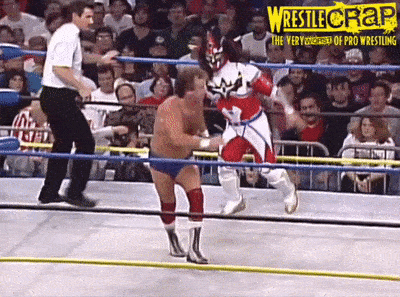
Speaking of awkward spots, there was no shortage of them at this event. Whenever you throw a bunch of guys into the ring together who’ve never worked together before, you’re going to get some miscues, such as in 1991 when WCW decided to showcase the high-flying Jushin Liger for American audiences for the first time by pairing him off against Mike Graham.
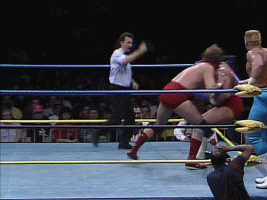
And who can forget 1992, when Erik Watts gave Steve Williams that dropkick? Had his dad booked Erik against Sky Low Low instead, that dropkick would have been perfectly fine.
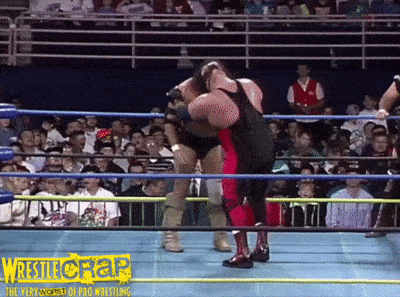
This year, Charlie Norris stopped dead in his tracks after getting Irish-whipped by Vader. Considering that just a year prior, Vader had broken a jobber’s back after he didn’t sell one of his moves properly, I’d say Charlie Norris was lucky to make it out of that match alive. At least, I assume he made it out alive, although he could very well have disappeared off the face of the earth after this show.
Vader finished off Norris with a powerbomb that nearly sent him clear out of the ring.
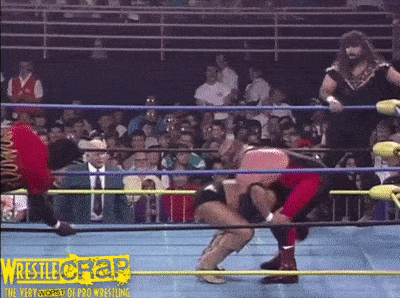
And by “him”, I mean Vader himself.
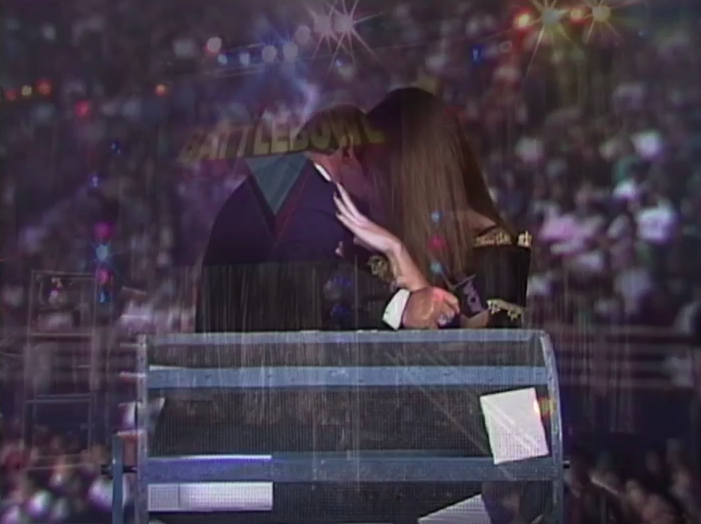
Back at the Lethal Lottery tumbler, Mean Gene and Fifi were getting rather close.
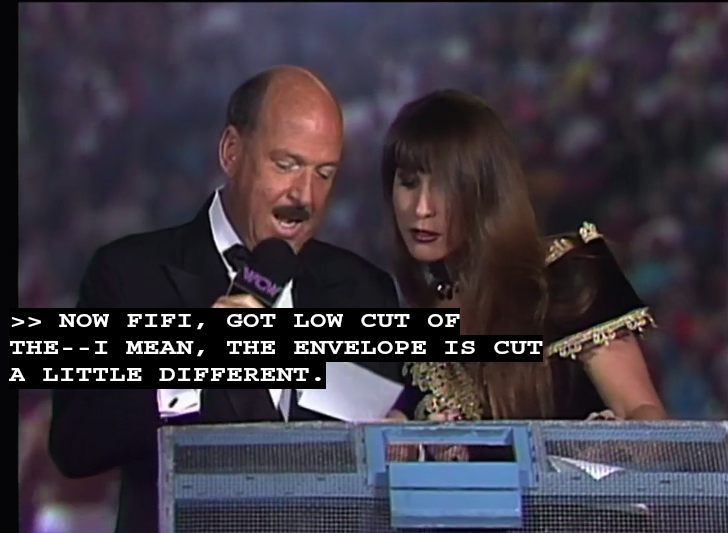
So close, in fact, that Gene got distracted reading the cards because of Fifi’s low-cut… envelopes.
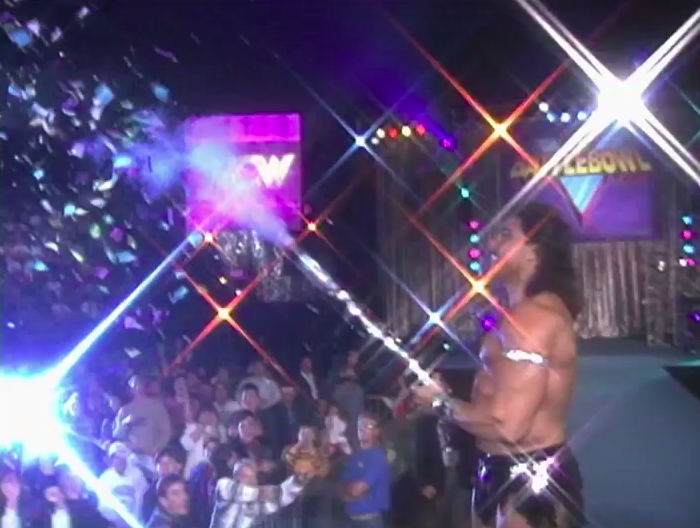
Okerlund regained his composure long enough to read the name of Johnny B Badd, who popped his giant glitter gun (symbolic of nothing, I assure you).
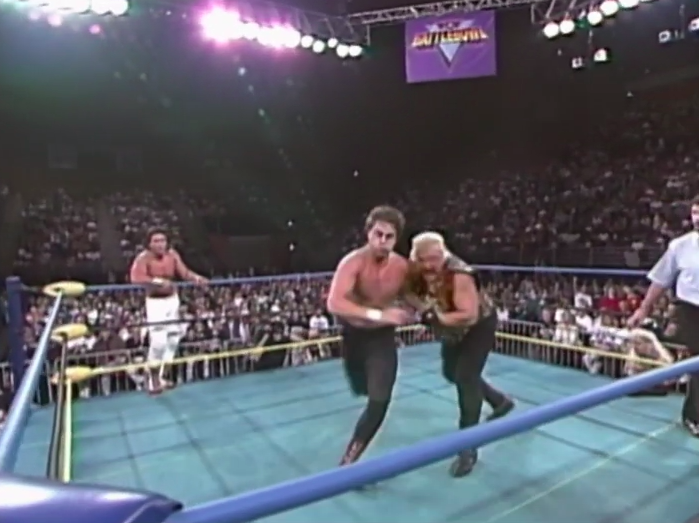
Though the event saw a lot of baffling tag teams thrown together, there were a few inspired pairings, such as Paul Roma and Erik Watts, who each received questionable pushes. They fell to Johnny B Badd and Nasty Boy Knobs.
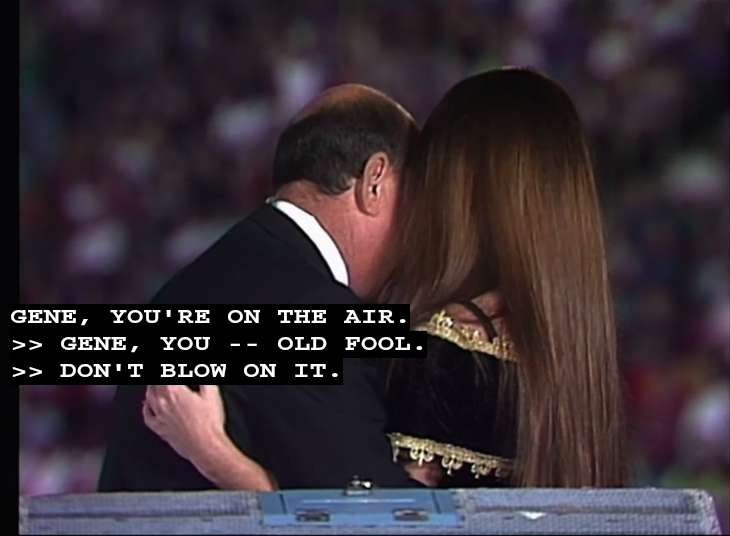
Speaking of nasty boy knobs, we cut to Mean Gene, whom Jesse Ventura called a “lecherous old fool”. WWE Network has censored the word, “lecherous”. Yes, “lecherous”.
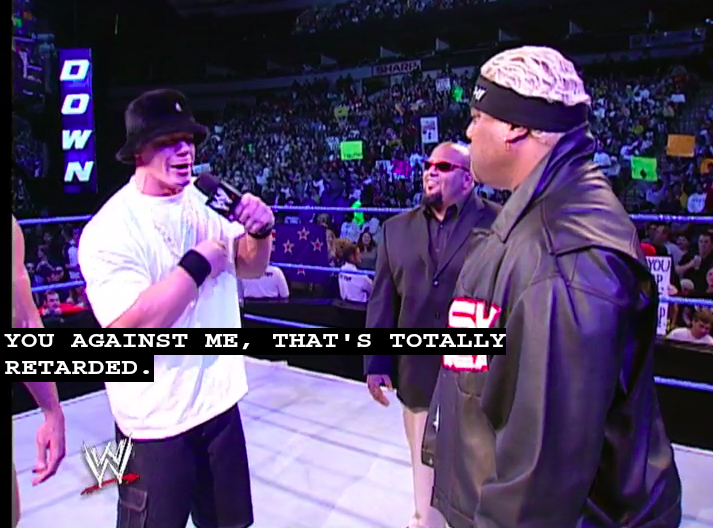
If they axed that word from the closed captioning, what would they even leave in?
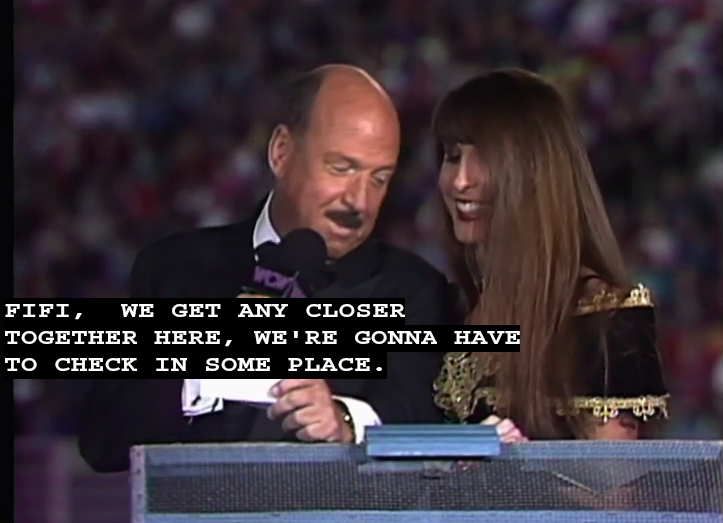
Gene claimed to be hard at work, and he was right – on both counts!
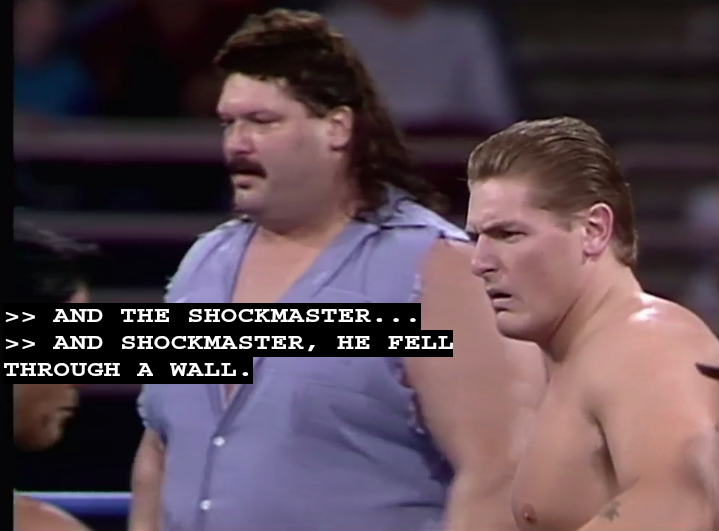
Next up, rivals Steven Regal and Ricky Steamboat teamed up against Paul Orndorff and The Shockmaster. In a moment neither of his 1998 gubernatorial opponents seized upon, Jesse Ventura remarked that The Shockmaster “must be part of the labor movement; look how stupid he is”. And I thought Ventura wanted to start a wrestlers’ union! The Body was lucky no one in Minnesota politics (and practically no one at all, for that matter) ordered this thing.
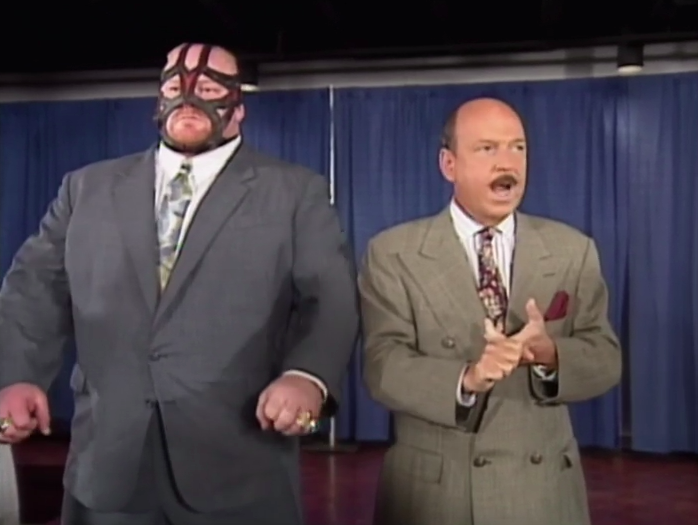
Next came footage of a supposed press conference held earlier in the week to announce the site of the eleventh Starrcade. Noticeably absent from this press conference was, you know, the press.
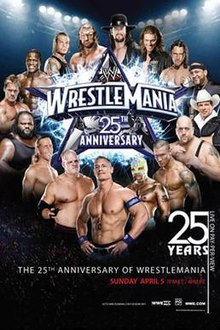
This Starrcade was dubbed the “10th Anniversary” (and correctly, for the first and only time in wrestling history, as the first Starrcade took place in 1983).
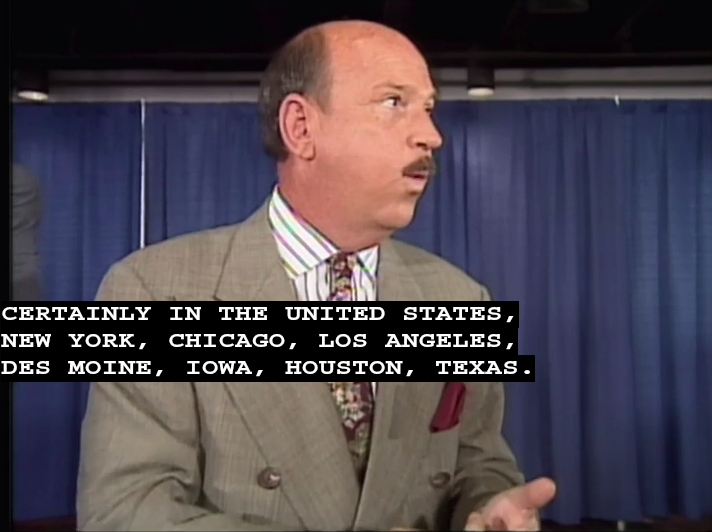
So important was Starrcade that the venue was decided an entire month in advance. Gene claimed that bids were submitted from such distant countries as the United Kingdom, Japan, South Africa, and Brazil, as well as such major American cities as, and I quote, “New York; Chicago; Los Angeles; Des Moines, Iowa…”
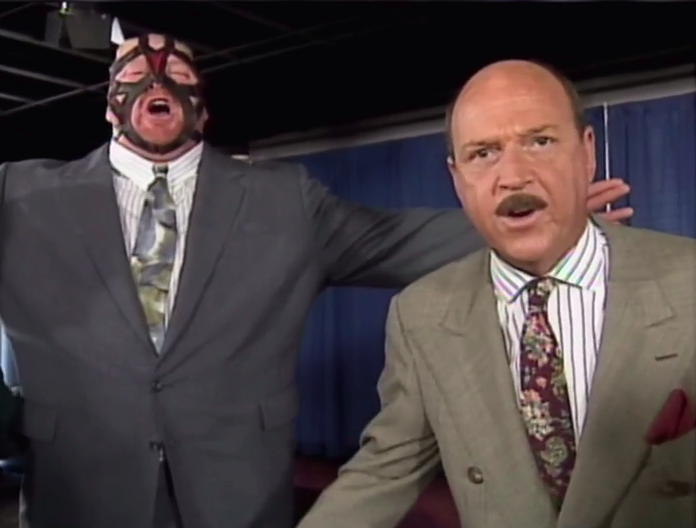
Representatives from five continents were on hand, Gene told us, apparently juuuust out of view of the cameras. With all these far-flung venues in play, it was clear to see that Starrcade had come a long way from its early days when it emanated from Greensboro, North Carolina four years in a row.
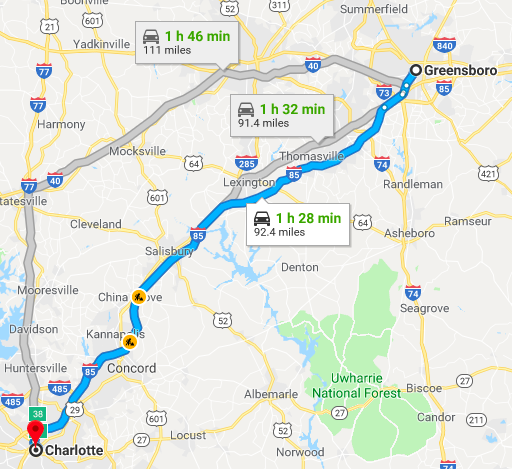
92.4 miles, to be exact, as Starrcade ’93 would be held in Charlotte. São Paolo would have to wait until next year, apparently.
Ric Flair then challenged Vader to a title match, vowing to retire forever if he lost. Obviously, the Nature Boy would go on to win that match, or else he would have honored that stipulation and never wrestled again.
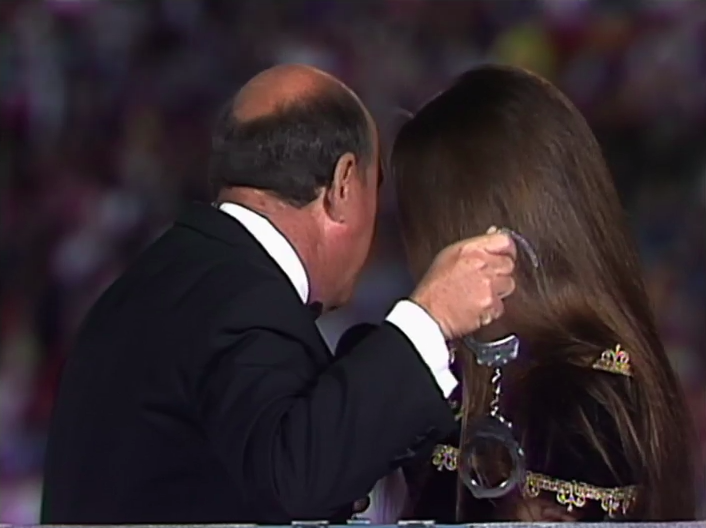
When cameras cut back to live action, Gene was whispering something to Fifi and holding up handcuffs like the Bossman or something. Hard time, indeed.
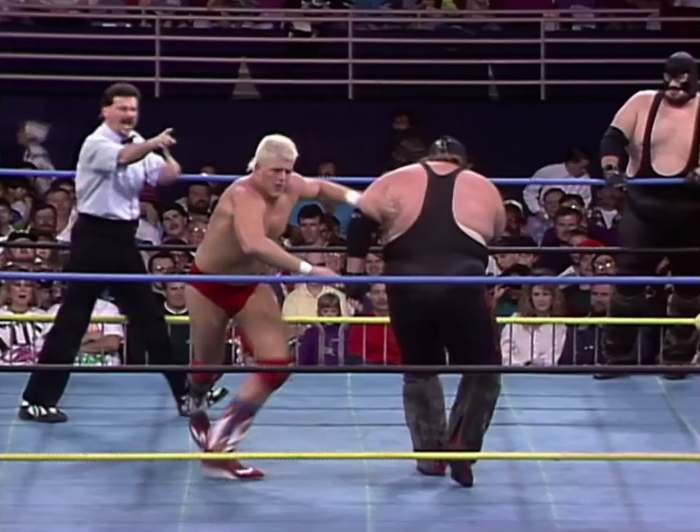
By this point, Okerlund’s adventures with the help were far outshining the actual wrestling, and nothing could illustrate this better than the next match, where Dustin Rhodes teamed up with one of the Colossal Kongs. Their opponents were the other Colossal Kong and The Equalizer, best known as Kevin Sullvan’s dyslexic brother Dave, or “Evad”.
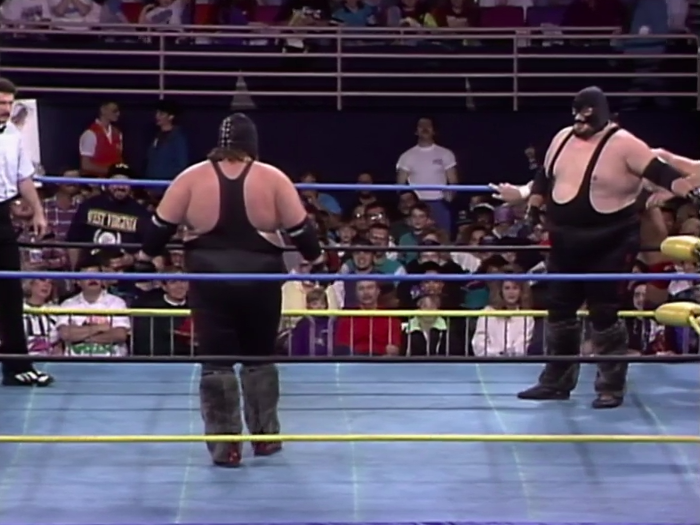
The match was tihsesroh.
Despite the poor in-ring showing and silence from the 7000 fans, Gene just couldn’t believe the action.
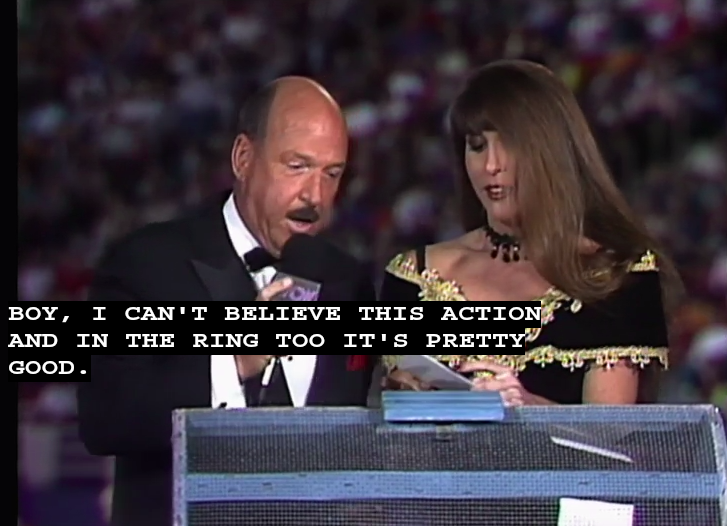
“And in the ring, too, it’s pretty good!” Double entendres aside, this assessment wasn’t strictly true. Nor was what I just said about 7000 fans, as only 3000 actually paid for their tickets.
Still, this pay-per-view was a more enjoyable way to spend the Thanksgiving season than, say, getting indicted.
The next match saw Jerry Sags team with the very first Battlebowl winner, Sting, who for whatever reason was not wearing his prestigious, custom-engraved Battlebowl ring. Remember, this coveted prize was to forever testify to the Stinger’s victory at Battlebowl, a feat Johnny B Badd claimed in a Muppet voice to be like a lifelong dream.
Sting and Sags faced Ron Simmons and Keith Cole of the Cole Twins.
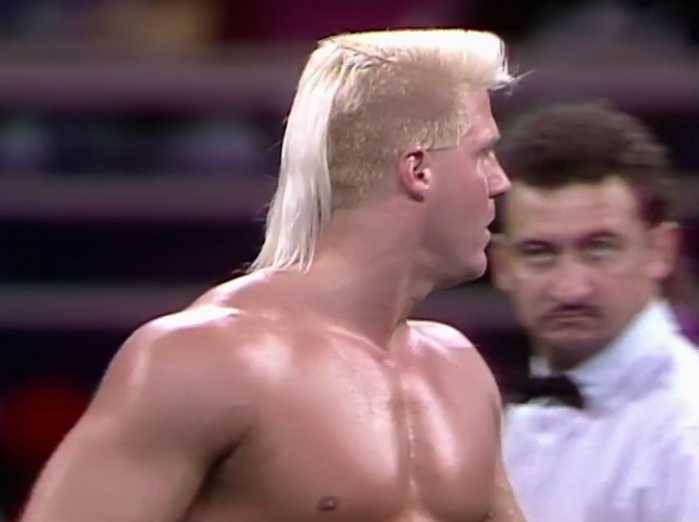
The night was just chock full of mismatches and bizarre pairings, and that was just Keith Cole’s haircut!
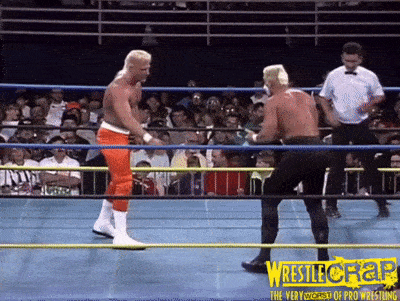
Sting and Cole actually called a mid-match truce to admire each other’s ‘dos.
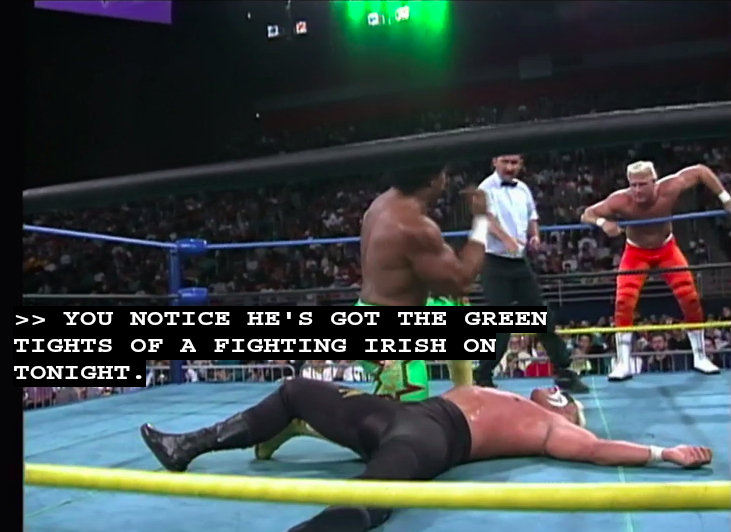
Sting and Sags ended up victorious over Cole and Ron Simmons, who Jesse Ventura spent all match implying had bribed his old football coach to throw a recent game against Notre Dame.
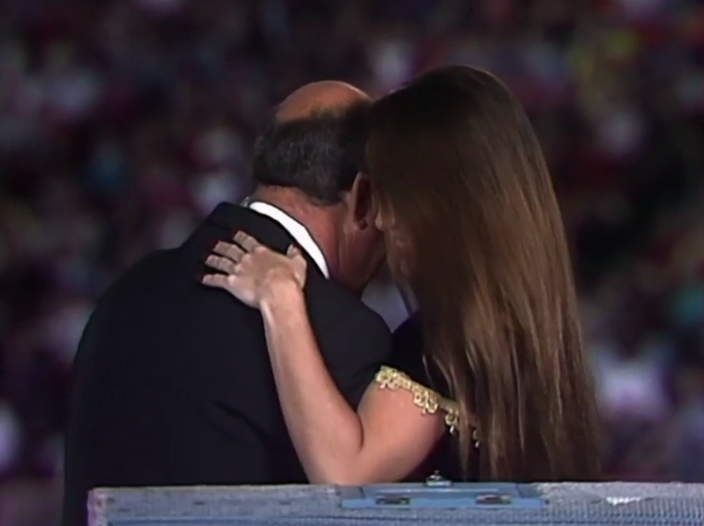
The real star of the evening interrupted his dancing with Fifi to announce the next match…
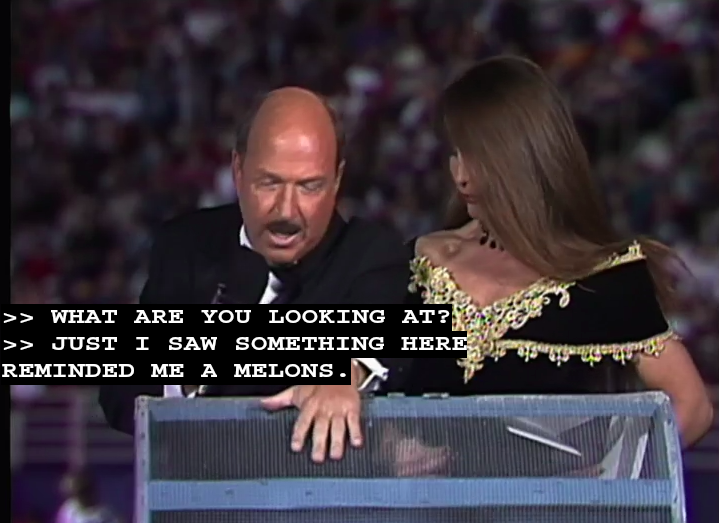
…and deliver a line about “melons” so devoid of ambiguity it didn’t even qualify as a double-entendre.
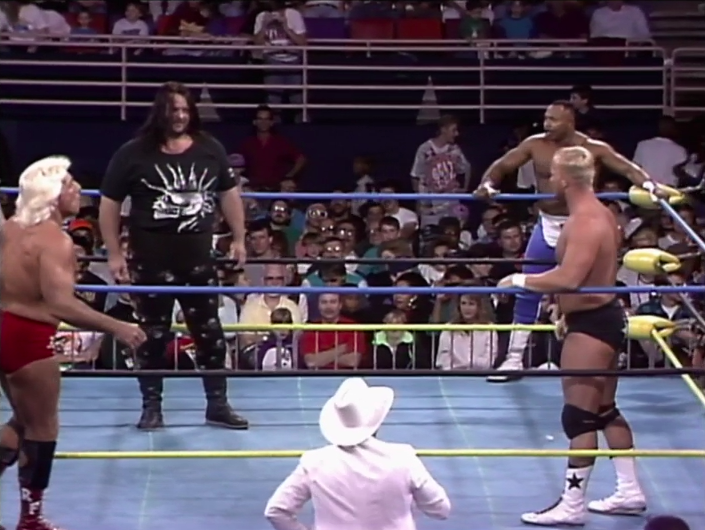
Ric Flair and Steve Austin teamed up to face 2 Cold Scorpio and Maxx Payne. Whatever happened to that guy?
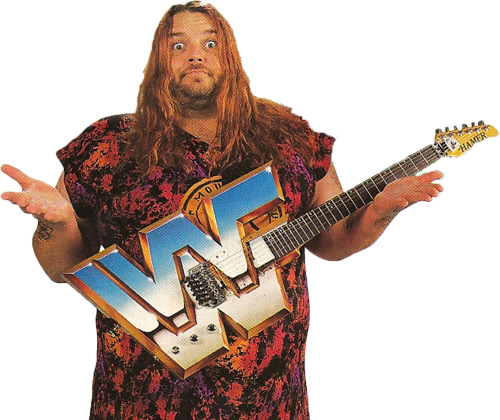
Payne and Scorpio ended up going down…
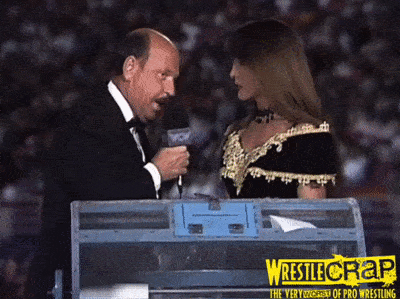
…just like Mean Gene.
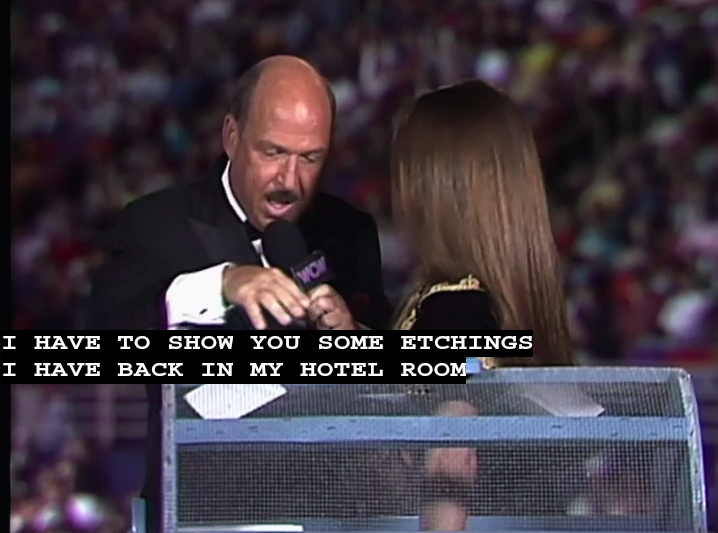
It’s a good thing Ric was in the ring and not watching the monitors backstage, or else he would have heard Mean Gene inviting Fifi to his hotel room.
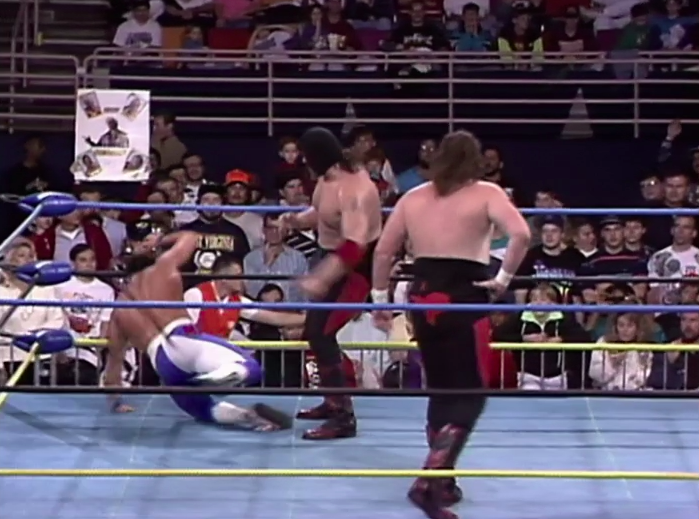
The future Godwinns wound up on opposing sides and briefly scuffled, but Tex Slazenger ended up bonding with his masked compadre over a post-match beating of Marcus Bagwell, as one does.
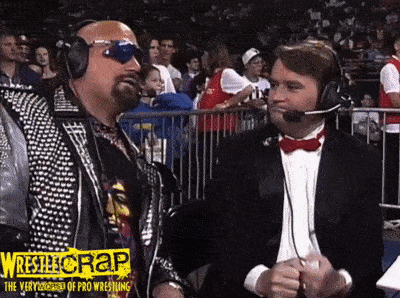
This time, it was Tony Schiavone’s turn to get silly, deciding that him vs. Jesse Ventura would make a better match than most of the night’s bouts.
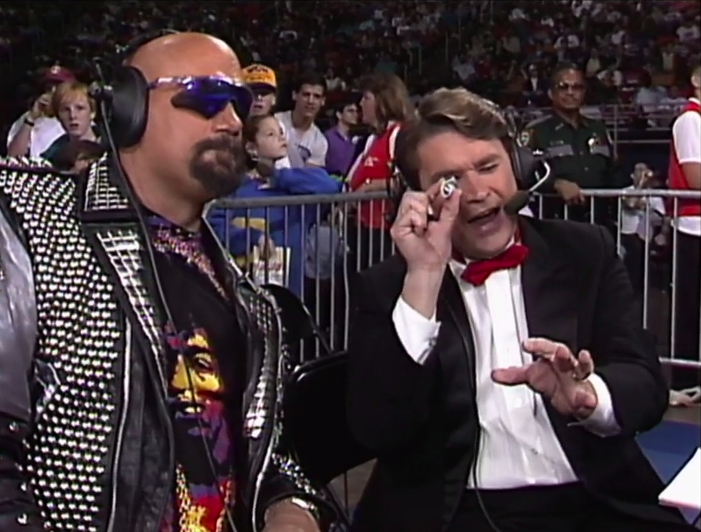
Schiavone was going to make his own entertainment, dammit, even if it meant playing make-believe as a pirate peering into his spyglass.
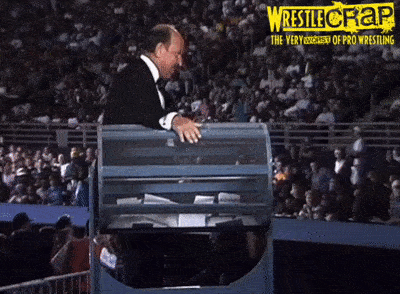
Thar she blows!
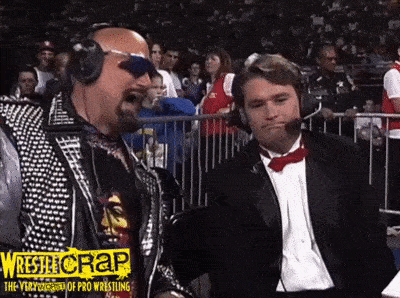
Tony might have been counting down the minutes until Battlebowl was over, but Gene was having the time of his life.
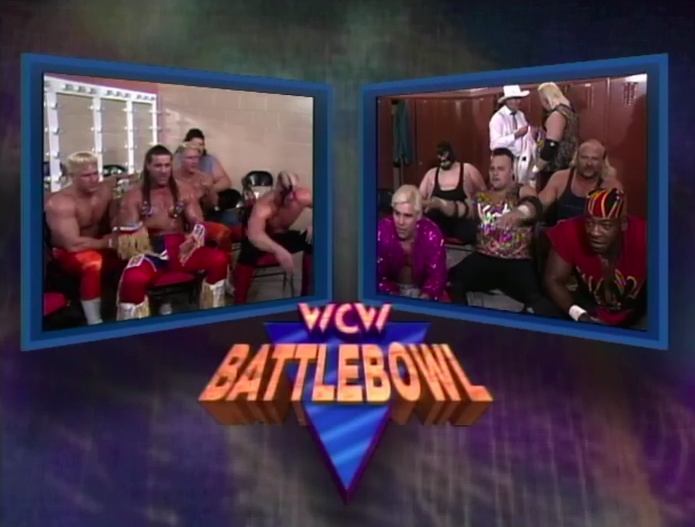
The final match was Hawk & Rip Rogers vs. Bulldog & Harlem Heat’s Kole, whom Mean Gene had mistakenly announced for the very first match. Either that, or WCW had given Booker T two entries and Stevie Ray none. That’s what I would have done.
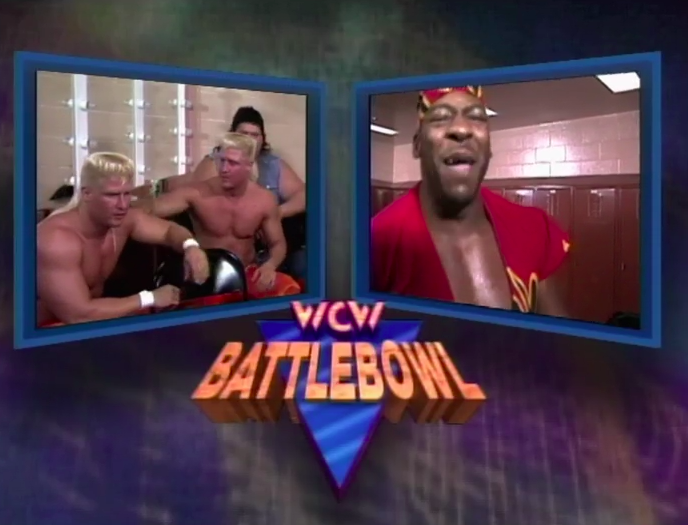
Poor Kent Cole was the only one on the whole roster who didn’t get picked.
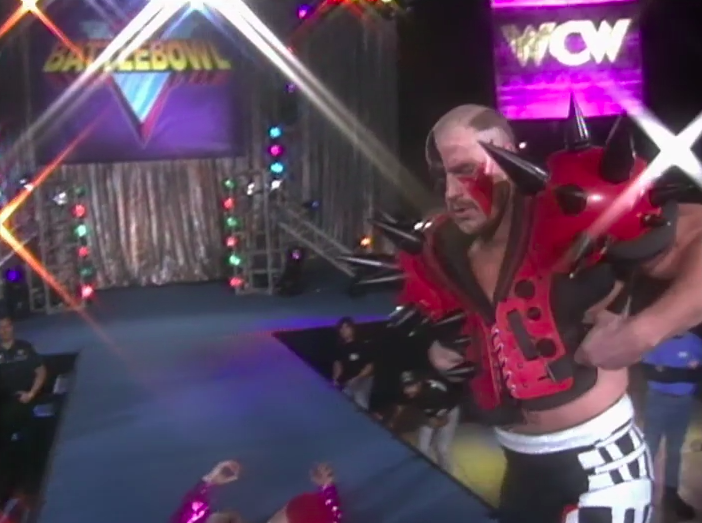
Rip Rogers was super pumped to be wrestling on pay-per-view, until he was waylaid by his own partner…
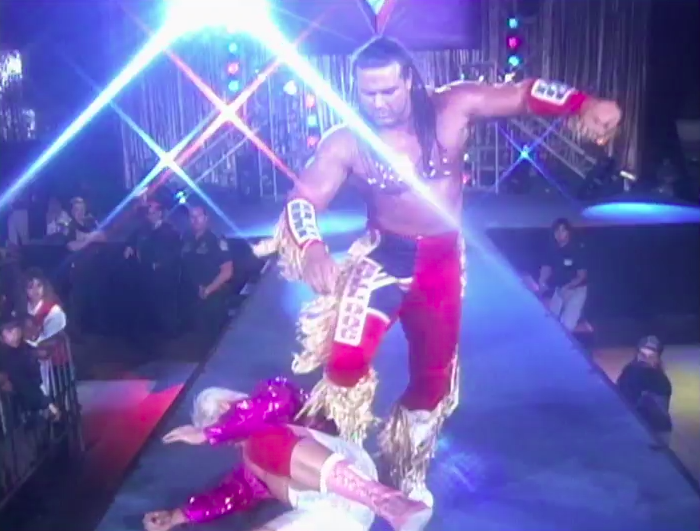
…then trampled by both his opponents…
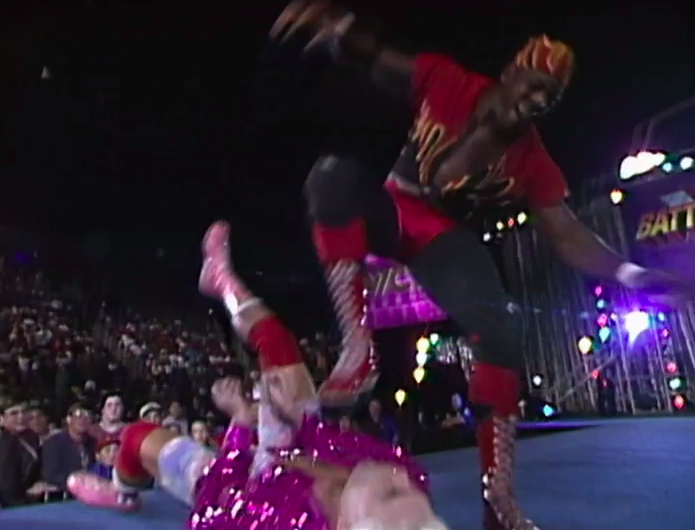
…before he even got into the ring.
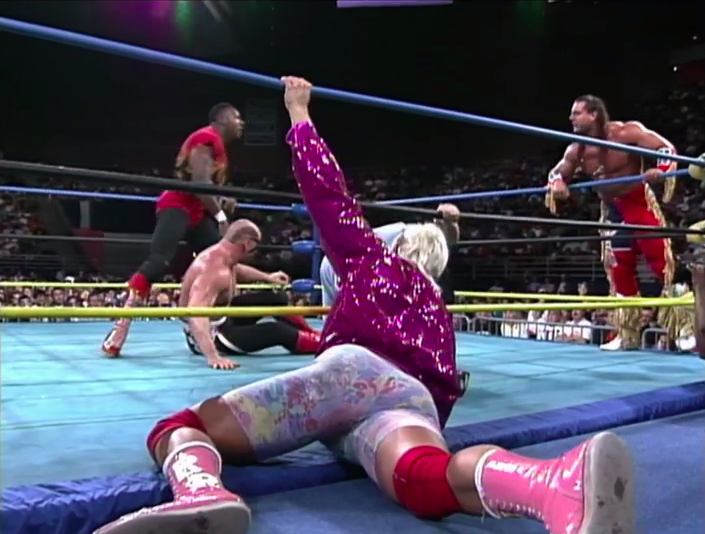
Bulldog, as a loyal babyface, spent the whole match cheerleading for his opponent Hawk, a good guy trapped in an unfair 2-on-1 situation. Of course, the reason he was in a 2-on-1 situation was because he had beaten up his own partner for no reason.
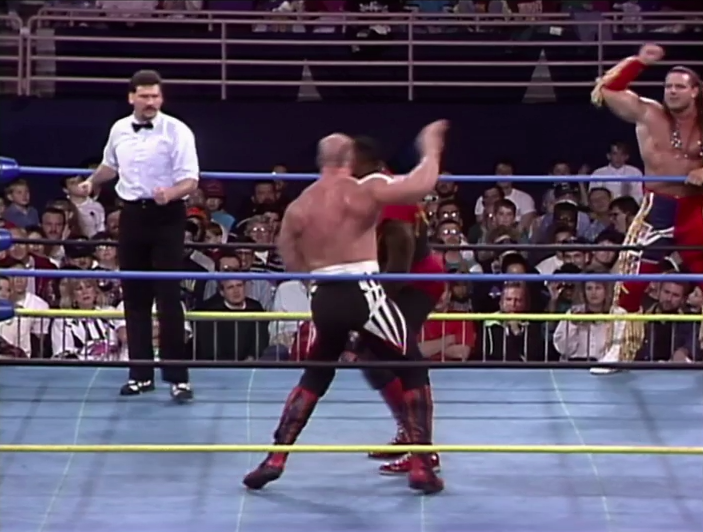
Bulldog even started an “LOD” chant, forgetting that that was his tag team’s WWF name. The announcers dutifully ignored this.
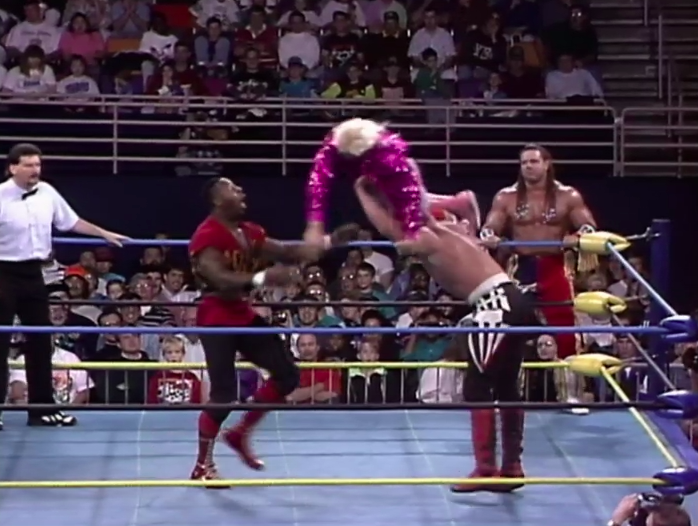
The match ended confusingly, as Hawk picked up a dazed Rip Rogers from the entranceway and threw him onto Booker T with no tag or anything. Rip made the pin for his team, and Davey Boy congratulated Hawk for eliminating him from the upcoming battle royal. Either Davey Boy was very dumb, or he really didn’t think much of that prestigious Battle Bowl championship ring.
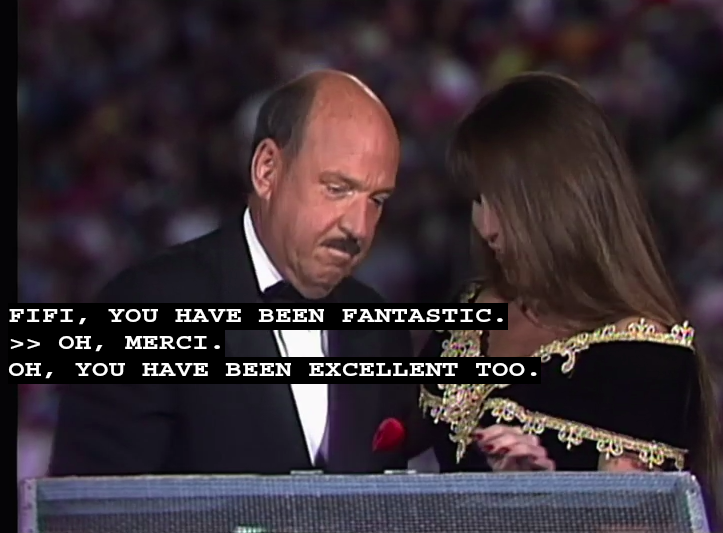
With the random drawings portion of the night complete, Mean Gene thanked the lovely Fifi for co-hosting, then dropped his mic as the mademoiselle half his age told him he had been “excellent”.
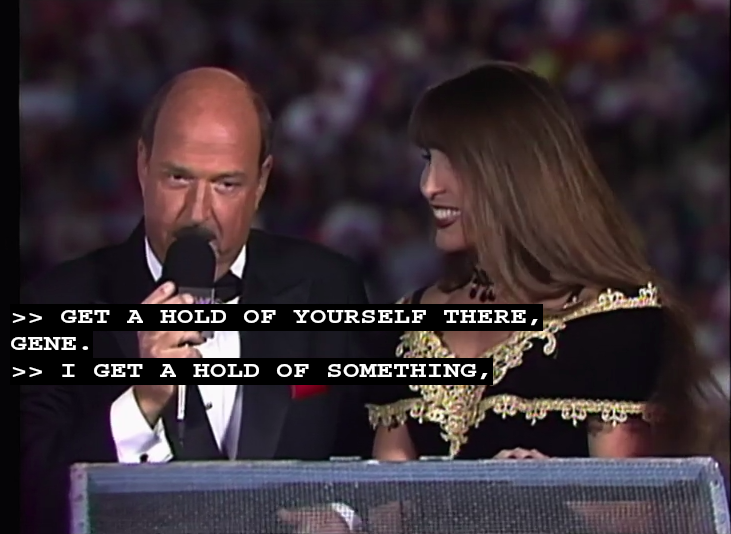
One last penis joke for the road, and it was time for the main event, the much-vaunted battle royal, featuring Hawk, Rip Rogers, uh, one of the Kongs, and, uh… I wasn’t writing the winners down, were you?
See, as if it weren’t hard enough for fans to keep track of the winners of all the tag matches (what with every pairing being random and not advertised ahead of time) WCW didn’t help matters by not featuring a single graphic the whole night to remind fans who had qualified for the main event.
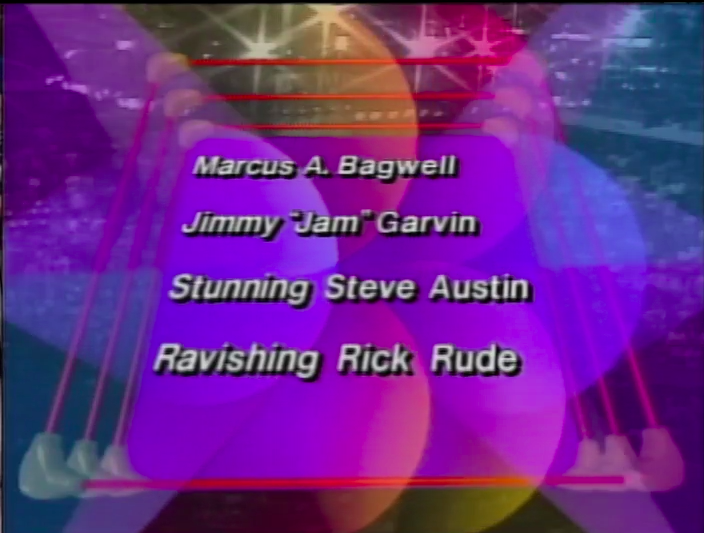
It’s not like the idea never occurred to anyone in WCW; they had done it in years past.
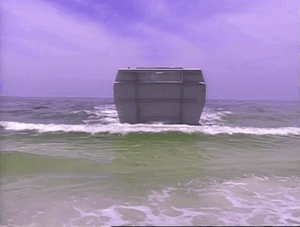
It’s as if WCW had wasted their whole 1993 production budget by July.
Now, the rules to the Battlebowl battle royal were always overly-complicated and full of surprises.
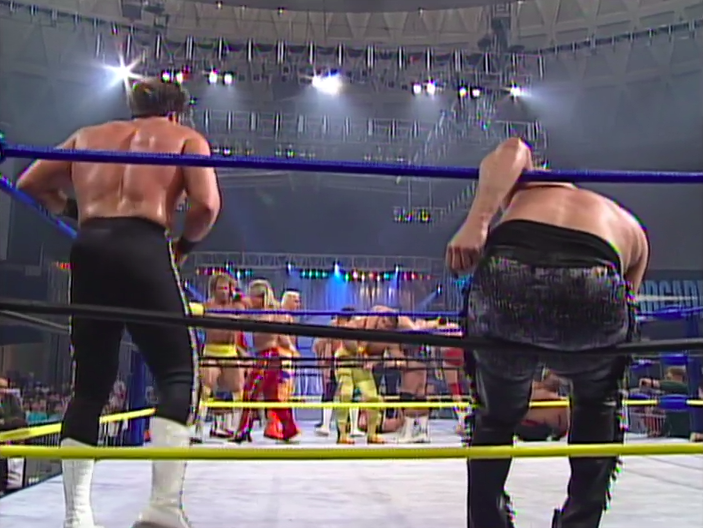
The 1991 battle royal spanned two rings, and to be eliminated you first had to be thrown over both sets of top ropes into the second ring, then thrown out of the second ring to the floor.
But then the announcers had to issue a correction saying you only had to go over the first ring’s top rope the first time around.
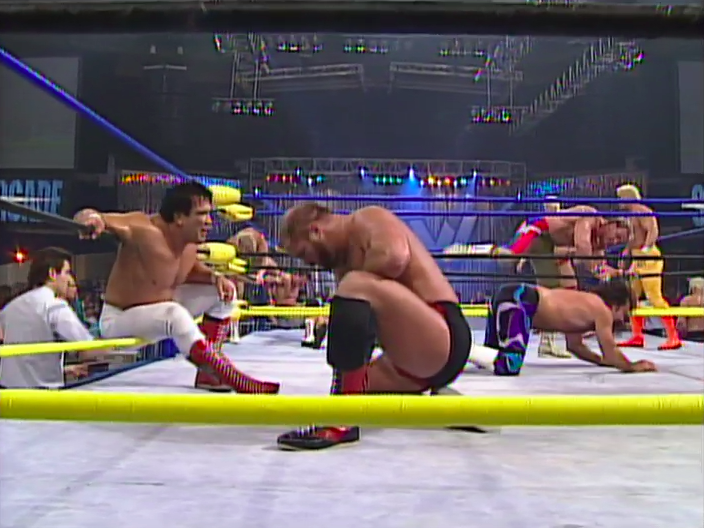
Then guys started getting thrown through the ropes into the second ring, and these counted as eliminations, too. Then guys just started walking into the second ring voluntarily, so the commentators just gave up.
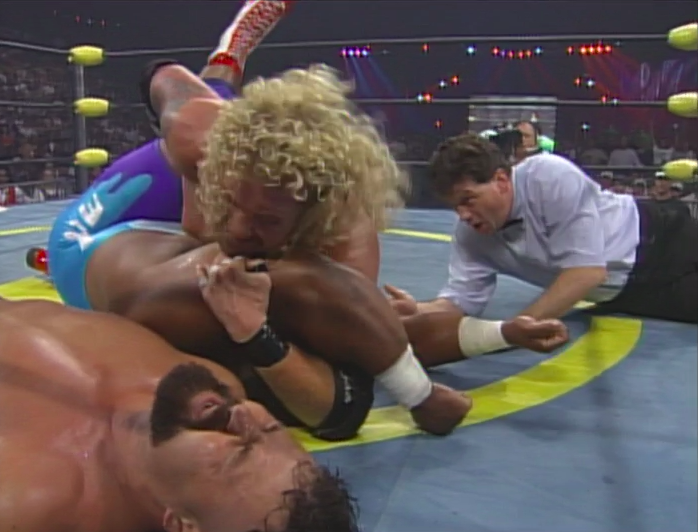
The 1996 edition at Slamboree was a standard battle royal until the very end, when Diamond Dallas Page started pinning people somehow.
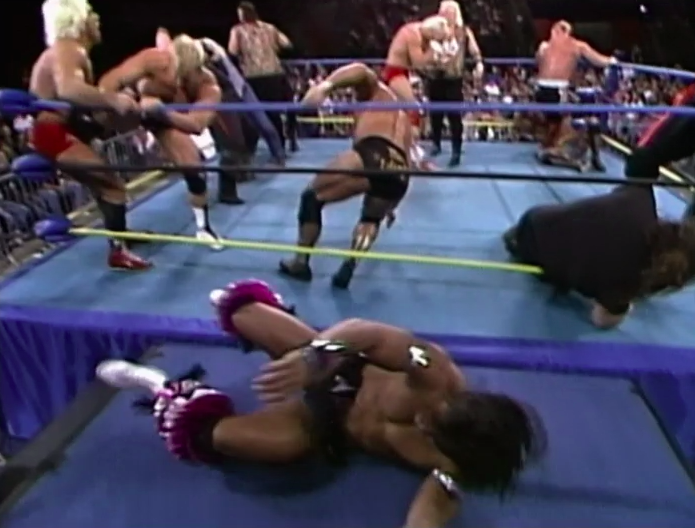
And in 1993, guys could get thrown onto the ramp without being eliminated, as it didn’t count as the arena floor. Tony Schiavone remarked that this battle royal was therefore tougher than usual because there were really only three sides of the ring where you could eliminate someone.
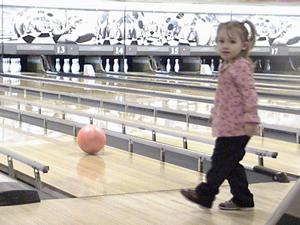
And bumper bowling is the hardest kind of bowling because your opponents can’t roll a gutter ball.
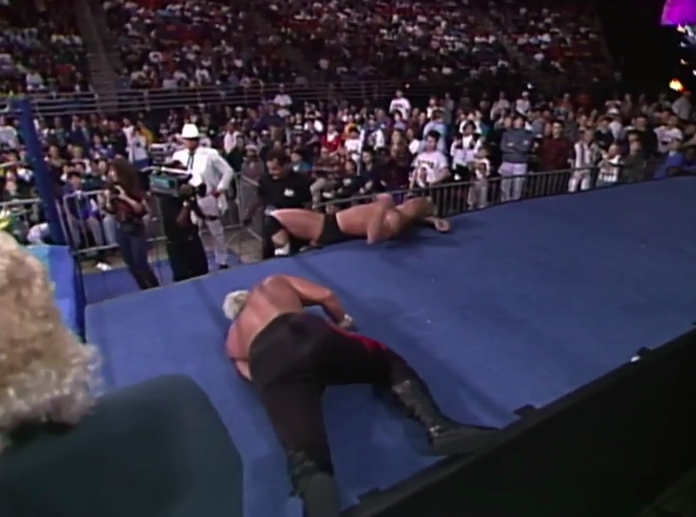
Still, that didn’t stop Steve Austin’s dumb ass from getting himself eliminated when he rolled the wrong way off the fifty-foot-long ramp onto the floor.
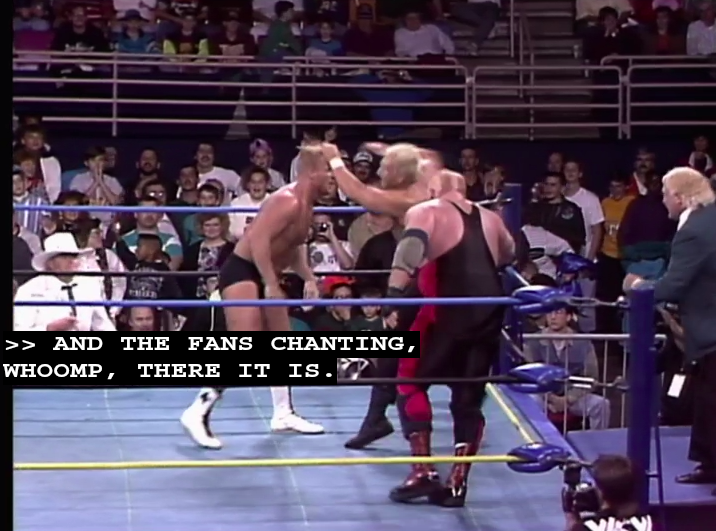
Fans finally came alive during the battle royal, chanting the kinds of things wrestling audiences chanted in 1993.
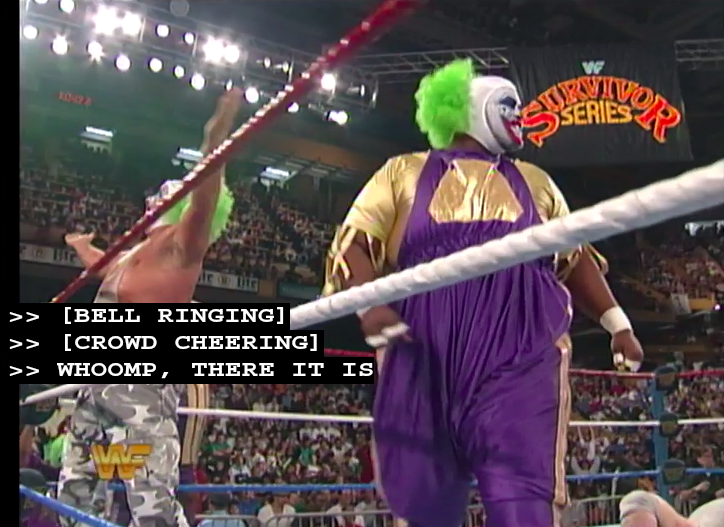
(Seriously, fans at Survivor Series four nights later chanted the exact same thing).
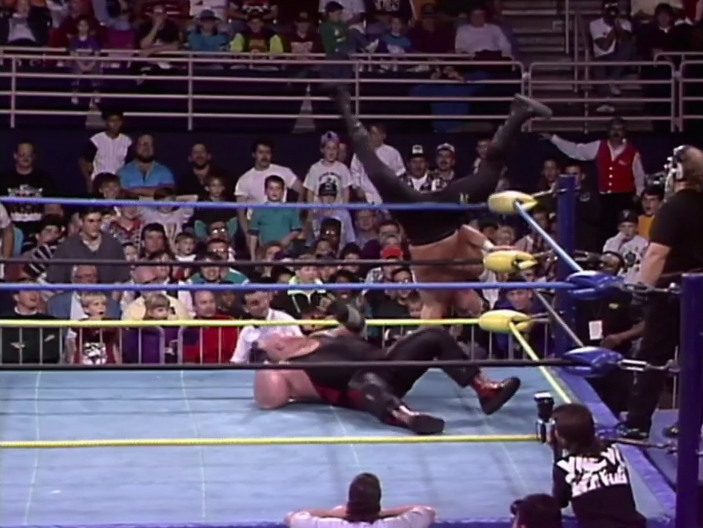
Vader ended up winning the battle royal. As he was already the champion and there was nothing at stake that would advance a wrestler’s career, the win seemed pretty meaningless, except of course for the Battlebowl championship ring he would receive.
About that ring… Readers, I’m starting to think there never was a ring.
At the first Battlebowl, there was no mention of any kind of prize for the winner, let alone a special ring.
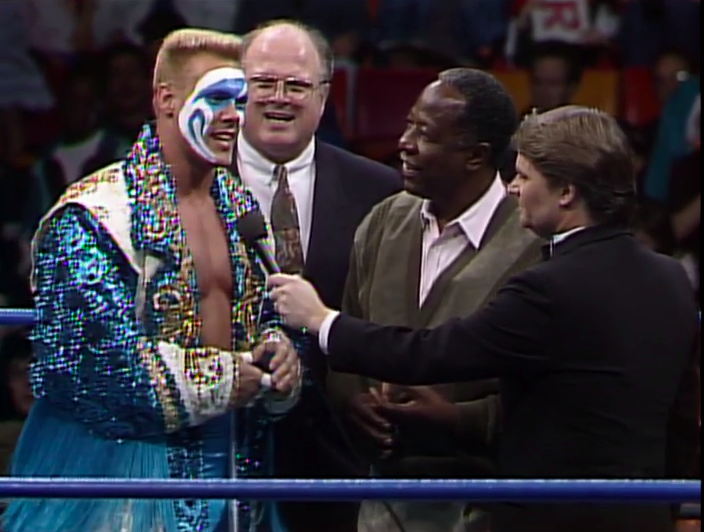
At the second Battlebowl in 1992, the fateful pairing of Hank Aaron and Bill Watts presented Sting with an engraved championship ring commemorating his victory the year before.
Or did they? No one ever actually saw the ring, as Sting never even took it out of the box.
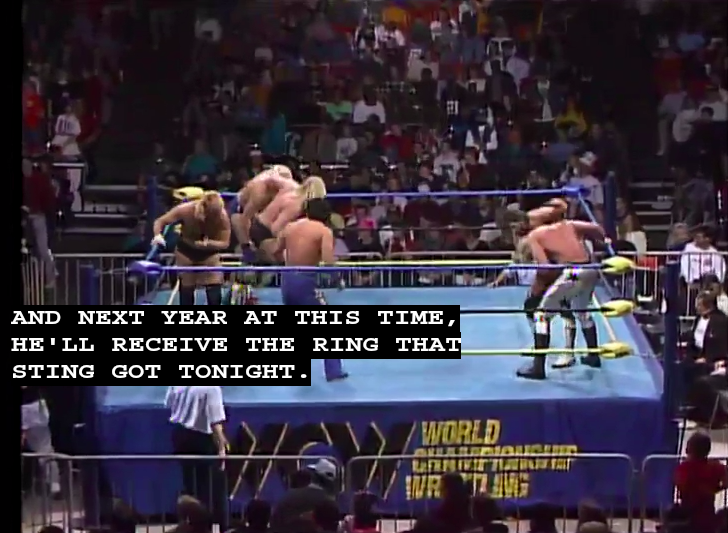
And later that night, the second Battlebowl was won by the Great Muta, who would conveniently return to Japan before ever receiving his Battlebowl ring.

In fact, the only ring we saw was a 1992 computer graphic.
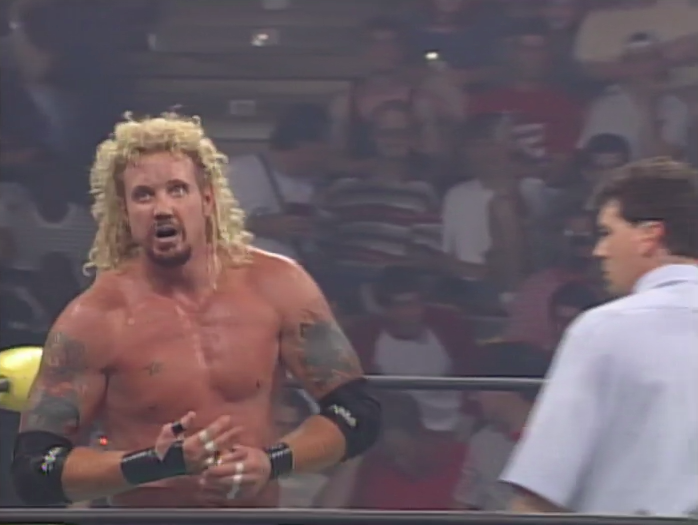
It wasn’t until the very last Battlebowl in 1996 that we would actually see the winner wear a ring.
This whole pay-per-view was built around a prize that was literally imaginary.
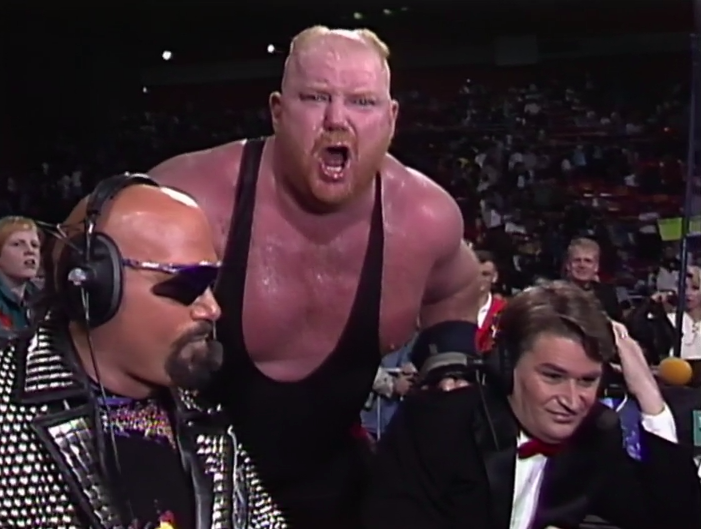
No wonder our winner looked so angry.


